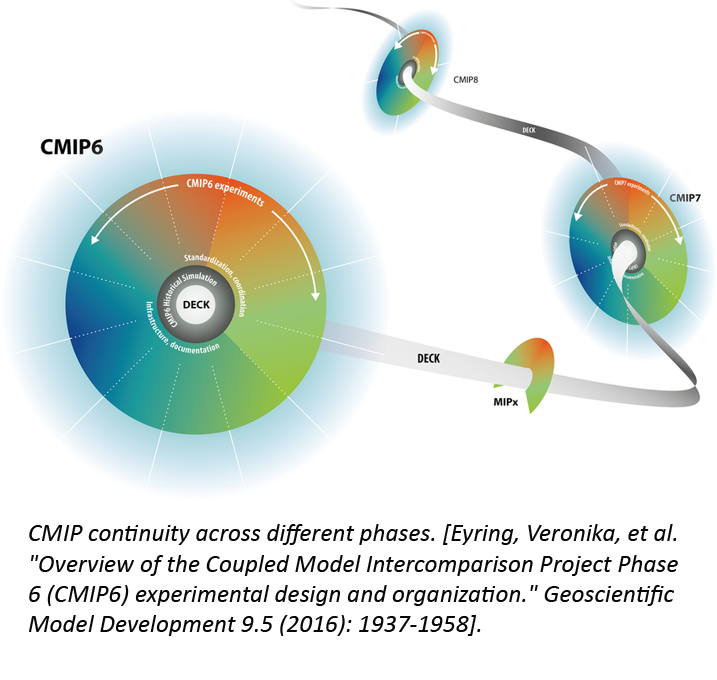This short movie gives insight into the world of climate modelling, particularly WCRP's initiative CMIP. CMIP provides climate projections that support essential WCRP activities and climate science worldwide, decision and policy-makers communities, in its objective to understand past, present and future climate changes. CMIP and its associated data infrastructure have become essential to the Intergovernmental Panel on Climate Change (IPCC) and other international and national climate assessments.
By European Space Agency
In 1995, the World Climate Research Programme (WCRP) launched a modelling project that would later become a crucial resource for international entities worldwide: the Coupled Model Intercomparison Project or CMIP. Today CMIP is highlighted at the ESA’s Living Planet Symposium 2022.
 The WCRP Coupled Model Intercomparison Project, or CMIP, is growing and its model outputs are increasingly used by many bodies responsible for driving the global climate process such as national governments and the private sector, as well as continuing to strongly support the Intergovernmental Panel on Climate Change (IPCC), including the recently released IPCC’s Sixth Assessment Report. The project has global relevance, informing international negotiations and decision-making.
The WCRP Coupled Model Intercomparison Project, or CMIP, is growing and its model outputs are increasingly used by many bodies responsible for driving the global climate process such as national governments and the private sector, as well as continuing to strongly support the Intergovernmental Panel on Climate Change (IPCC), including the recently released IPCC’s Sixth Assessment Report. The project has global relevance, informing international negotiations and decision-making.
“Application of CMIP multi-model results has expanded with successive IPCC Assessment Reports”, explains Eleanor O’Rourke, director of the CMIP International Project Office, adding that they “provide detailed information about the role of human activities in driving historical climate change, and provide quantitative projections of future climate.”
By bringing modelling centres from around the world together, CMIP benchmarks, intercompares and improves state-of-the-art climate model simulations and future projections. The main objective is to better understand how the climate has changed and how likely it is to change, address outstanding scientific questions, and develop tools to evaluate and further improve the models.
“Its purpose is to undertake a common set of climate simulations to obtain a multi-model perspective of climate change,” says O’Rourke, adding that “this helps evaluate climate models, leads to improvements in the model simulations and provides a better understanding of past, present, and future climates”.
CMIP data is freely available to the global climate community, a positive consequence of its open access infrastructure and standardised format. For example, around 30 petabytes of data were downloaded from the Earth System Grid Federation (ESGF), as part of CMIP’s sixth phase, CMIP6. Growing from comparing responses from a handful of models, CMIP is now a global enterprise with more than 50 modelling centres participating in the latest CMIP6 cycle, across six continents.
The range and number of users outside the modelling community has also grown beyond policy makers to those developing climate services, planning how to adapt to a changing climate and managing climate risk across the public and private sector across the globe.
The latest generation of CMIP models have many improvements over previous phases including higher resolution, inclusions of additional Earth System processes and new components made possible by increased computing power, but uncertainties and biases remain, which the CMIP and wider climate modelling community continue to investigate.
This week the recently launched WCRP CMIP International Project Office (CMIP-IPO) and its role supporting CMIP activity is presented at the ESA’s Living Planet Symposium 2022. Discussion around CMIP’s evolution, its continued policy decision support and the challenges and opportunities at the interface of the Earth Observation and modelling communities will be addressed.
CMIP’s International Project Office
CMIP is coordinated by two subcommittees of the WCRP Working Group on Coupled Modelling (WGCM): the CMIP Panel and the WGCM Infrastructure Panel (WIP).
With greater use cases and more demand for CMIP products, an international call to host a dedicated project office was issued by the WCRP in 2020 and the European Space Agency (ESA) was selected. In March of this year, the CMIP International Project Office opened alongside ESA’s Climate Office at its European Centre for Space Applications and Telecommunications (ECSAT) facility in Oxfordshire, United Kingdom.
“Hosting the new CMIP office aligns with ESA’s long-term strategic commitment to provide high-quality observation-based climate data records to support the modelling community,” said Susanne Mecklenburg, Head of ESA’s Climate Office, on the announcement of the ECSAT facility in February.
“The accurate spatial and temporal view provided by satellites helps to reduce uncertainties in climate models, gives greater confidence in their results and ultimately supports nations to deliver effective climate action and fulfil their pledges under the Paris Agreement,” she added.
The CMIP International Project Office coordinates the project under the governance of the WCRP Working Group on Coupled Modelling (WGCM) and is part of the developing Earth System Modelling and Observations (ESMO) Core Project, which coordinates all modelling, data and observations activities across WCRP and their key partners.
Learn more about

